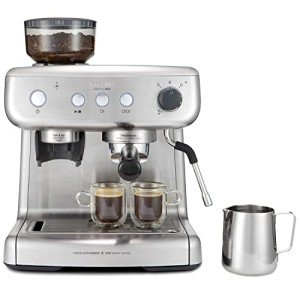Heat Exchange Espresso Machines: A Comprehensive Guide
Espresso machines have actually developed considerably throughout the years, dealing with the requirements of home baristas and coffee professionals alike. Amongst these machines, heat exchange espresso machines have gained appeal due to their ability to provide constant performance and extraordinary brew quality. In Top Espresso Machines , we will check out the operations, advantages, and essential features of heat exchange espresso machines, supplying a detailed understanding for both possible purchasers and coffee enthusiasts.
Understanding Heat Exchange Technology
Heat exchange espresso machines run on a distinct concept that permits simultaneous water heating for developing and steaming. They are equipped with a single boiler that utilizes a heat exchanger system. This function is substantial as it allows users to brew espresso while steaming milk concurrently, promoting performance in the coffee-making process.
How Does a Heat Exchange Espresso Machine Work?
The process starts with the machine's water inlet filling the boiler. As the water heats up, it turns to steam. The innovative heat exchanger uses hot steam to heat extra water in a separate passage developed particularly for the brew group. This implies that water can reach the ideal brewing temperature level without waiting on the boiler to adjust. The essential steps include:
- Water Fill: Water is drawn into the boiler.
- Heating Process: The boiler heats up as water is converted into steam.
- Heat Exchange: Steam heats up water in the heat exchanger tube.
- Developing: Water from the heat exchanger is pushed through coffee grounds, extracting the flavors required for a rich espresso.
This process permits for quick temperature modifications and enhanced coffee extraction.
Benefits of Heat Exchange Espresso Machines
Heat exchange espresso machines use numerous advantages, particularly for those seeking to optimize their coffee experience. Here are some essential advantages:
- Simultaneous Brewing and Steaming: Users can brew espresso while steaming milk, making it ideal for hectic cafes and home baristas who value effectiveness.
- Temperature Stability: The boiler's steam pressure helps preserve a steady temperature, which is crucial for consistent espresso extraction.
- Versatility: The design enables quick changing between brewing and steaming, making it simpler to produce various coffee drinks, from lattes to cappuccinos.
- User-friendly: Models often come with accessible controls, making it practical for both beginners and experienced baristas to produce quality drinks.
- Professional Quality: Heat exchange machines are often used in commercial settings, providing users with high-quality developing efficiency in your home.
Key Features to Look for in Heat Exchange Espresso Machines
When considering the purchase of a heat exchange espresso machine, there are several features that one need to consider:
- Build Quality: Look for machines made of resilient products, such as stainless steel or brass, ensuring longevity.
- Boiler Size: A larger boiler will hold more water and sustain greater output over time.
- PID Temperature Control: This function assists preserve constant brew temperatures, which can boost the coffee-making procedure.
- Group Head Design: Machines with a saturated or semi-saturated group head provide much better temperature level stability.
- Alleviate of Use: User-friendly user interfaces and intuitive controls improve the overall experience for baristas at all skill levels.
- Steam Wand Quality: An excellent steam wand with proper insulation and flexibility permits much better texturing of milk.
- Water Reservoir Size: Depending on your requirements, think about how typically you wish to fill up the water reservoir.
Contrast of Popular Heat Exchange Espresso Machines
To much better comprehend the options readily available in the market, listed below is a contrast table of some popular heat exchange espresso machines:
| Machine Model | Boiler Size | PID Control | Rate Range | User Ratings |
|---|---|---|---|---|
| Profitec Pro 700 | 2.0 L | Yes | ₤ 2,000-₤ 2,500 | 9.5/ 10 |
| Rocket Espresso R58 | 1.8 L | Yes | ₤ 2,400-₤ 2,800 | 9.4/ 10 |
| Elekta Bianca | 1.8 L | Yes | ₤ 2,500-₤ 3,000 | 9.6/ 10 |
| La Spaziale S1 Vivaldi II | 1.5 L | Yes | ₤ 1,800-₤ 2,200 | 9.2/ 10 |
| Bezzera Magica | 1.2 L | No | ₤ 1,600-₤ 1,800 | 9.0/ 10 |
FAQs About Heat Exchange Espresso Machines
What is the primary difference between a heat exchange and a dual boiler espresso machine?
While both types can brew espresso and steam milk at the very same time, dual boiler machines have separate boilers for brewing and steaming. In contrast, heat exchange machines make use of a single boiler and a heat exchanger to attain the same function.
Are heat exchange machines appropriate for beginners?
Yes! Numerous heat exchange machines are developed with user-friendly functions, making them available for beginners. With correct assistance and practice, users can rapidly produce quality espresso.
What kind of maintenance do heat exchange espresso machines require?
Regular upkeep consists of descaling, cleaning the boiler, examining seals and gaskets, and keeping the group head clean. Regular maintenance makes sure durability and consistent efficiency.
Can I use a heat exchange machine for various kinds of coffee drinks?
Definitely! Heat exchange machines allow users to create a range of coffee beverages, including espresso, lattes, cappuccinos, and more.
Heat exchange espresso machines represent a blend of innovation and custom, supplying coffee lovers with the tools needed for crafting the perfect cup. Their ability to all at once brew and steam, integrated with accurate temperature level control, makes them an engaging choice for both home baristas and specialists. With the right understanding on functions and maintenance, users can open a world of charming coffee experiences, guaranteeing that each sip is as delightful as the last.

